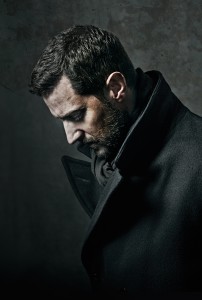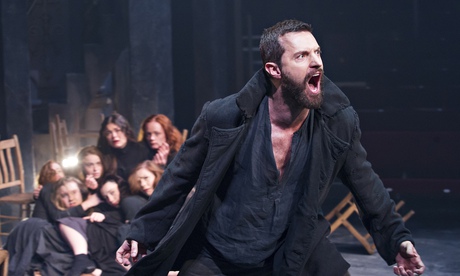 As TORn’s readers know, our very own Thorin Oakenshield – actor Richard Armitage – is currently appearing as John Proctor in The Crucible at The Old Vic in London. Staffer greendragon went along to see the show, and she’s written up what she says is ‘half review, half an attempt to capture the atmosphere for those who won’t get to see this production.’ Here’s what she had to say:
As TORn’s readers know, our very own Thorin Oakenshield – actor Richard Armitage – is currently appearing as John Proctor in The Crucible at The Old Vic in London. Staffer greendragon went along to see the show, and she’s written up what she says is ‘half review, half an attempt to capture the atmosphere for those who won’t get to see this production.’ Here’s what she had to say:
My last trip to The Old Vic was to see another Hobbit cast member: Sir Ian McKellen was appearing there as Widow Twankey, in the pantomime Aladdin. That was back in 2005; and years before that, when I was not yet even a teenager, I used to have a season ticket to see all four shows each year at the theatre. At that time, The Old Vic was a familiar friend; but as I entered the venue this July, it was barely recognizable – not because of my long time away, but because of the unusual set-up of the space for the Old Vic’s ‘theatre in the round’ season.
Long lines of people waited patiently to get into that evening’s performance; the house was full, using all the seats circled around the stage. (I asked an usher where the nearest Ladies’ restroom was, and was rather surprised to receive the answer, ‘Just walk across the middle of the stage and you’ll see it in front of you.’ Really?? In fact, that is exactly what I did, weaving amongst the wooden chairs – haphazardly arranged, just one overturned – which made up the scant ‘preshow’ set.)
The walls of the theatre were draped with grey, grubby ground cloths, covering the Old Vic’s ornate auditorium. The set was made up of exposed brick and concrete, with a solid, grey floor with metal tracks (not used in this production, but presumably for a truck in another show) running across the middle. The effect was of being in an abandoned warehouse of some kind – an industrial, stark and yet somehow timeless space. As we gradually took our seats, smoke drifted through the space, and there was a smell of burning herbs. A quiet, dull but insistent throb hummed in the background, nagging at the subconscious. Our eyes, ears and noses were all being drawn into the tense atmosphere of Salem before the show even began.
The lights dimmed, and Tituba, Reverend Parris’ Barbadian servant, entered, chanting and wafting smoke from the cauldron of burning herbs. Her incantations seemed to conjure the players – people began to stride into the space. Dour, silent, eyes downcast and almost faceless in the half light, the cast filled the stage, some standing, some sitting; the tall, bearded figure of John Proctor took up a central seat. A pause, and then they raised their eyes to look accusingly at the voyeurs surrounding them. Right from the start, this was a production which was not going to let the audience off the hook; we are as guilt as any in this hysteria.
As the cast of unhappy villagers began to leave the scene, removing chairs as they went, Abigail Williams and her gaggle of girls strode on. They looked strong, intimidating, a gang who were in control – so much so that they brought with them the set for the first scene: Betty Parris’ bedroom.
This silent action at the opening was mirrored several times throughout the production. Arthur Miller’s play is not short, but here it was further lengthened by mimed interplay between scenes. Furniture was moved on and off by the cast, passing and crossing each other with baleful stares or averted eyes. Usually it was Abigail and her gang who created the scenes – reminding us each time how the power in Salem had been put into the hands of children.
The Crucible is a play which astonishes me each time I see it. Miller’s writing is almost unbelievably powerful; so compelling is the piece, that pretty much any staging of it is likely to be decent. Director Yaël Farber and her cast achieve much more than just decent; this is a dark, brooding, intense production. Costumes and furniture evoke the 17th century, but are so stark and minimal that they could almost be any period. Thus Farber succeeds in reminding us of the harshness of life in Massachusetts of the 1600s, but at the same time we feel that the action could be unfolding anywhere, in any time. We see how frightened people, feeling threatened, look for any scapegoat; how those on whom the blame might fall will point the finger at others, in order to escape; and how those in power can easily be swept down a path, from which they are too embarrassed to turn when it seems they have made a mistake. The speed with which things unravel in Salem is shocking, yet all too believable. Reverend Hale appears to put words in the girls’ mouths, in his eagerness to help the community to find the source of their troubles; when he himself begins to see the errors they are all making, it is too late to turn back. The dangers of religion and law becoming blended and confused, and church dictating to state, are scarily relevant today.
In all this gloom and anxiety, however, Farber’s production also brilliantly highlights the comedy of Miller’s script. Again, I was repeatedly struck by the strength of this play; Miller’s point is razor sharp, yet his writing contains humour, and somehow room for doubt and questioning. Delivering this incredible text, some actors fared better than others: William Gaunt as Giles Corey, Paddy Navin as Sarah Good and Adrian Schiller as Reverend John Hale stood out to me as being particularly compelling. Anna Madeley, who played Proctor’s wife Elizabeth, was also powerful, but occasionally her performance was marred by indistinct speech – a problem which plagued a few of the cast.
 Richard Armitage was, as one would expect, a strong central figure in the maelstrom whirling around him. With a short, stubbly beard, and closely cropped hair, he was a dark presence, often only half lit – just the kind of role he believes suits him best! (To quote Richard: ‘Do you know what? I’ve always said of myself, I look better in the dark and I look better dirty.’) He, too, was occasionally unclear in his speech; and sometimes he seemed rather stuck in declamatory mode, delivering lines such as ‘We will burn together!’ [hmm, sounds familiar…] in a manner which seemed melodramatic in this stark, revealing play. This high intensity was vocally evident; several reviewers have mentioned the hoarseness and strain which can be heard in his usually rich, mellifluous voice. Susannah Clapp, in The Guardian newspaper, wrote that the production ‘contains some unnecessary keening and writhing. It also contains a lot of shouting. Everyone is nearly always at full roar, sometimes improbably so: would two clandestine lovers really start yelling at each other in his house? The poison of rumour relies on stealth as well as force.’ Certainly, I would have liked to see Armitage trust his wonderful stillness more; in the intimate scenes between Proctor and his wife, his performance was utterly compelling.
Richard Armitage was, as one would expect, a strong central figure in the maelstrom whirling around him. With a short, stubbly beard, and closely cropped hair, he was a dark presence, often only half lit – just the kind of role he believes suits him best! (To quote Richard: ‘Do you know what? I’ve always said of myself, I look better in the dark and I look better dirty.’) He, too, was occasionally unclear in his speech; and sometimes he seemed rather stuck in declamatory mode, delivering lines such as ‘We will burn together!’ [hmm, sounds familiar…] in a manner which seemed melodramatic in this stark, revealing play. This high intensity was vocally evident; several reviewers have mentioned the hoarseness and strain which can be heard in his usually rich, mellifluous voice. Susannah Clapp, in The Guardian newspaper, wrote that the production ‘contains some unnecessary keening and writhing. It also contains a lot of shouting. Everyone is nearly always at full roar, sometimes improbably so: would two clandestine lovers really start yelling at each other in his house? The poison of rumour relies on stealth as well as force.’ Certainly, I would have liked to see Armitage trust his wonderful stillness more; in the intimate scenes between Proctor and his wife, his performance was utterly compelling.
Overall, this excellent production of an outstanding play didn’t quite manage, for me, to climb to extraordinary heights. It’s hard to say exactly why this was. Fascinating programme notes once AGAIN reminded me of Arthur Miller’s genius and insight; but I was left without feeling that I had seen Yaël Farber’s own insight. I wanted her to show me something else in the play, something which had special meaning for her and for her cast. This is not to say that I wanted some ‘unusual’ staging just for the sake of it, nor that I needed a ‘different take’ on the play. I just wanted to feel more how the words spoke to Farber, and to the actors; what did they each take away from it, personally?
When Elizabeth tells John, ‘Whatever you will do, it is a good man does it,’ I found myself wondering what Miller intended when he wrote those words. Did he want to forgive his friend Elia Kazan, who had cooperated with the House Un-American Activities Committee? Or perhaps the action of the play seems rather to highlight this cooperation – confessing to ‘sins’ you did not commit – as the greatest crime, and it is only by avoiding this capitulation that Proctor finds his ‘good’. Miller’s writing leaves room for us to ponder these questions; but I left the Old Vic wondering if Farber had come to any conclusions in her own mind. Not sensing her insight, I wasn’t quite as exhilarated by The Old Vic’s The Crucible as I might have been.
This is, however, a minor point, which reduced the production to ‘only’ excellent and fascinating theatre, (as opposed to mind-blowingly extraordinary theatre!). According to Kevin Spacey (The Old Vic’s Artistic Director), Richard Armitage ‘has wanted to play John Proctor since his late teens’. It’s a great role for Armitage, and a wonderful chance to see him on stage, in a compelling production. The Crucible runs at The Old Vic until 13 September; do go and see it if you can.
[Book tickets for The Crucible]


